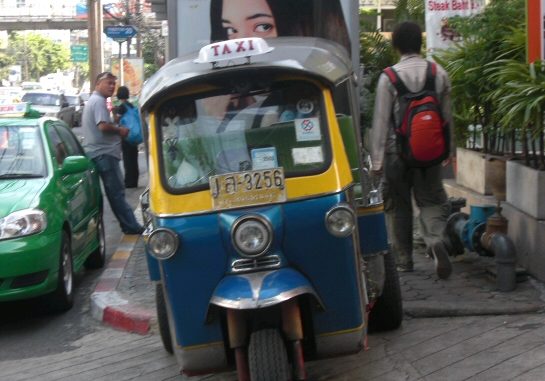
Bangkok is one of the jewels of rising Southeast Asia; a burgeoning major world city that already boasts over 8 million people with maybe 15 million estimated in the metropolitan area, if you count uncounted immigrants from Laos, Myanmar, and other neighboring countries who have traveled to Thailand for sanctuary and a job. Bangkok is at least two cities in one, maybe more — it is a dynamic new elegant sophisticated high-tech city bursting from the seams in skyscrapers, high-tech companies, and skyline elevated trains. That Bangkok is rising quickly from the Bangkok of old — crumbling infrastructure; hot, dirty inner-city streets and flats; incredible poverty by the railroad tracks; filthy water in the canals that route through the city; and bad air pollution from the intense traffic that bring the streets of Bangkok to a halt.
That’s the Bangkok I ignorantly plowed forth into on a Sunday afternoon at 3:30pm, having taken the bus from the airport to the inner city, looking for the Intercontinental Hotel. First thing you notice after you land and get outside the gates at Bangkok Airport is that everything isn’t as clear as you though it might be, given that everyone in Thailand is supposed to speak English. They actually speak English as a secondary language; their primary language, Thai, fills all the signs — it is quite pretty; very ornate — with English subtitles (if you’re lucky). And everyone speaks English but many have an accent, so it is difficult to understand what they are saying. It took several iterations of the same conversation with the girl at the bus ticket stand to get it clear in my head that I needed to board bus #3 outside the terminal. She pointed on the map where the Intercontinental Hotel would be and told me what stop to get off, a name steeped in Thai pronunciation I knew there would be no way I’d remember it but figured I’d ask the bus driver while on board. The bus driver spoke no English whatsoever. So I’d be winging it into town, jumping off the bus at some point; hoping to find the right subtitle.
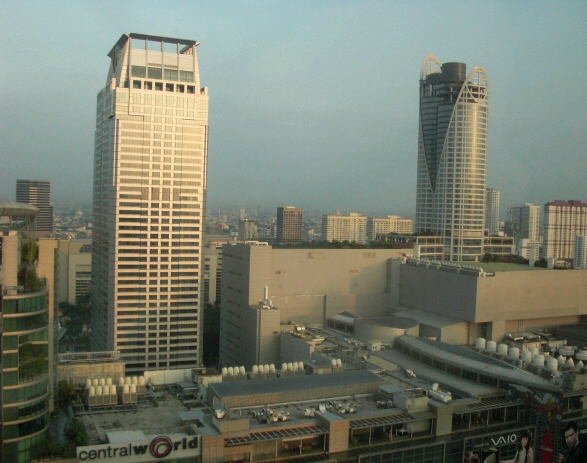
It’s a quick 30 minute highway ride into town from the airport, but once we hit center of town, the bus became mired in stand-still traffic. It would move 10 feet, then stand still for 10 minutes. Then move another 10 feet, and wait another 10 minutes. After about 40 minutes of that, and moving about three blocks, some of the passengers started bailing. I asked an older Asian gentleman on the bus where the Intercontinental Hotel might be, presenting him with my free tourist map — not nearly as detailed as the map that the bus-ticket girl at the airport instructed me on. He told me to go one block back and one over and then down. I got out to find my hotel by foot.

Bangkok is hot and getting hotter. I was there in rainy season — August 15 through August 20; supposedly a cooler time of year, I would learn later. Still it seemed to be 95 degrees Farenheit with 100 percent humidity every day. The sun blazes down. You sweat standing in place. The Thai people I talked to say it’s much hotter now than it was 20 years ago, due most probably to Global Warming. Twenty years ago, said a Thai coworker who has lived there his whole life, you could drive around in a car without air conditioning. Now, he said, that’s a hard thing to bear.
 Thai people are the nicest, most polite people in the world. They are like miles ahead of all other races. They literally pray to you when they see you – people you don’t even know put their hands together in prayer, and bow their heads to you. That’s the Thai way of saying hello, or goodbye, or good morning. The Thai lady at the airport wasn’t actually that friendly; and neither was the cab driver on the way back, in retrospect. This confirms my belief that people are people, no matter the social customs or gestures. Yet still, years of social niceties may have imbred the Thai people into thinking nice thoughts all the time; it certainly seemed that way from all the other people I met while there.
Thai people are the nicest, most polite people in the world. They are like miles ahead of all other races. They literally pray to you when they see you – people you don’t even know put their hands together in prayer, and bow their heads to you. That’s the Thai way of saying hello, or goodbye, or good morning. The Thai lady at the airport wasn’t actually that friendly; and neither was the cab driver on the way back, in retrospect. This confirms my belief that people are people, no matter the social customs or gestures. Yet still, years of social niceties may have imbred the Thai people into thinking nice thoughts all the time; it certainly seemed that way from all the other people I met while there.
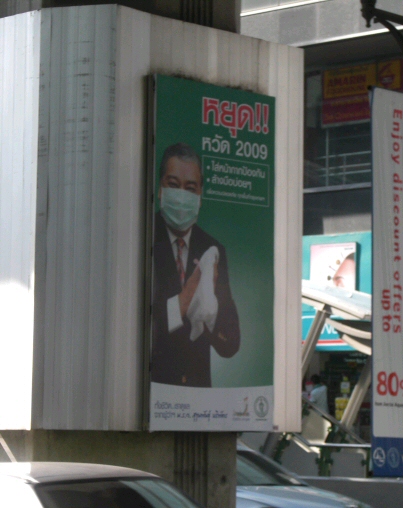
And so after walking with my luggage down a block, and then over a block, and then down another several blocks, I started to doubt whether the older Asian fellow on the bus had understood me, or there had been some miscommunication. Instead of jumping into one of the many cabs — hundreds of cabs — that were stuck in traffic heading one way, and racing by the other way, I asked a young fellow walking by if he knew where the Intercontinental was. He did. He sent me off in another direction, north — up across the street from the British Embassy. It was a 20-minute walk, but when I arrived there was no Intercontinental Hotel there. The soldiers at the gate to the British Embassy told me the Intercontinental was the other way, back towards where I had been but further down. It took me another 20 minutes to get to that spot, and still, I couldn’t find the hotel amongst all the modern skyscrapers in that part of town. By this time I was starting to sweat profusely, so I attempted to duck into the flagship store of a shopping mall which looked to have AC. Miraculously, as I was heading up the steps, I ran into the same young guy who gave me the directions previously, and he told me he couldn’t believe I’d missed it — it was back by the British Embassy. He even used his cell phone to call the hotel, and verified that they were on the same street as the British Embassy. Thai people are so nice. So I walked back. I was pretty much drenched in sweat by the time I got back to the British Embassy, and again, the only hotel there was the Swiss Hotel. The guys at the gate to the Swiss Hotel told me the Intercontinental was back where I just had been — 20 minutes walk back the other way. So finally I jumped in a fucking cab and he drove me to the hotel — ironically a block away from where I was when I originally asked directions of the young guy — for all of 150 Bots (or $4). It was clear the young guy was thinking the Swiss Hotel was the Intercontinental. He had even told me the Intercontinental was a non-descript, one-story low slung building. The Swiss Hotel was that. The Intercontinental is a 37 story modern skyscraper of the most elegant interior. I’d be living in luxury for the next several days. There was even a Starbucks across the street.
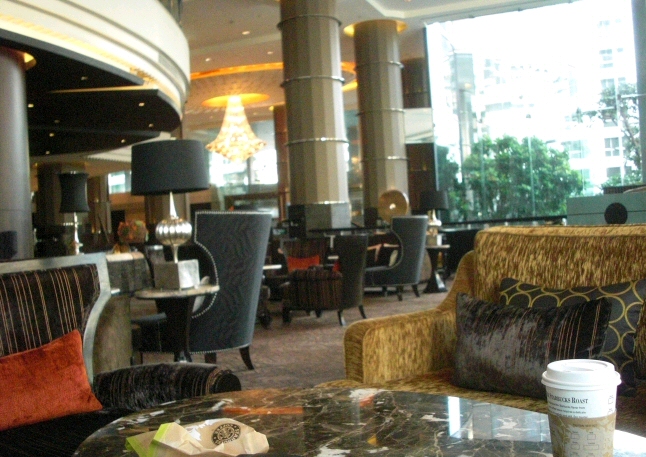

My initial misadventure was the closest thing I got to sightseeing the first three days of the trip. It was all work; visiting clients and speaking at a user group. My sightseeing consisted of seeing how the Thai people worked, visiting places like True Technologies — the Verizon of Thailand, Bank of Bangkok, and Thai Airlines. In itself a great sightseeing trip.
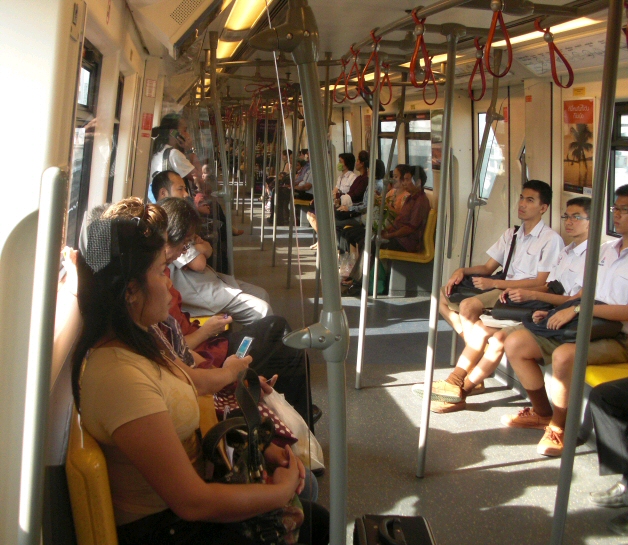
Swine Flu is a major issue in the summer of 2009, and Thailand is taking it more seriously than in the states. One out of every 100 people I saw was wearing a mask — all government employees were apparently mandated to wear one, and the governor of Bangkok had advised the general public to wear masks, I read in the paper. So it gave an ominous undertone to my visit. At True Technologies, a security guard zapped my neck with a laser thermometer to take my temperature — employees or visitors are not allowed in if a fever is detected.

Blue Jeans
On my final day in Bangkok, I had a morning to see the city before a customer visit in the afternoon. So I treked out from the hotel just after 8am. I had two goals — explore the marketplace that I’d seen when first arriving — the area I was in when I jumped off the bus; and secondly, to see if I could walk down to the center of the city, by the river, where the map showed all the monuments were, like the King’s palace. I’m not a big fan of monuments, but I did want to get a close-up look at the river.
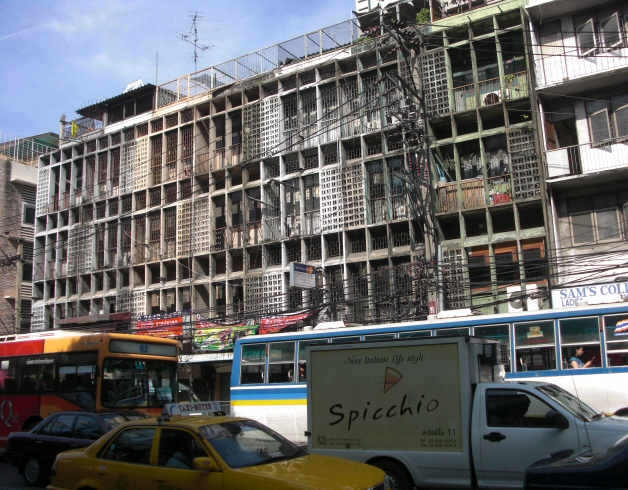
I walked to the market and headed north through the residential city streets of Bangkok. Living conditions in this area were squalid. First you have to keep remembering it’s hot in Thailand. Really fucking hot and humid. So you sweat just walking from here to there. Even the Thai people sweat. It’s impossible not too. People shield themselves from the sun as much as they can. Windows in high tech office buildings have a dotted sheathing on them which acts as a filter, allowing you to look out but not let the sun in as powerfully as it would. And noone wears shorts — the Thai people wear blue jeans almost exclusively. That suits me well as I’ve always worn blue jeans in even the hotest NYC weather. I thought maybe they were upholding a James Dean image, but it wasn’t until I returned that the wife pointed out that maybe they were shielding their legs from the sun. Good point.
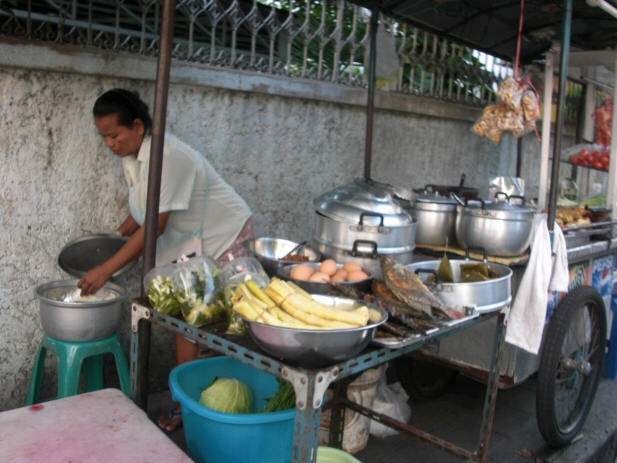
Walking through the streets of Bangkok reminded me somehow of Brooklyn in the 1960’s — not that it looked anything like that — but I remembered my grandfather’s store; he was a shoemaker, and was always working with his hands. Everyone works with their hands in the inner city of Bangkok — women on the street doing tailoring work with a sewing machine; people making food and selling it on the street; and yes, I saw one or two shoemakers. The buildings were dirty, and there was no air conditioning anywhere.
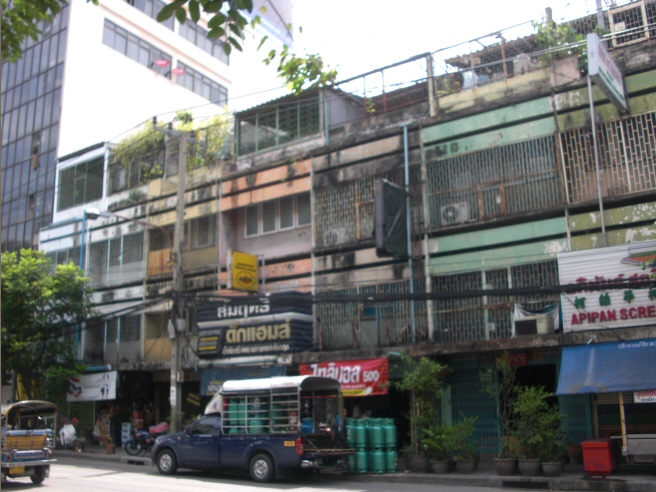
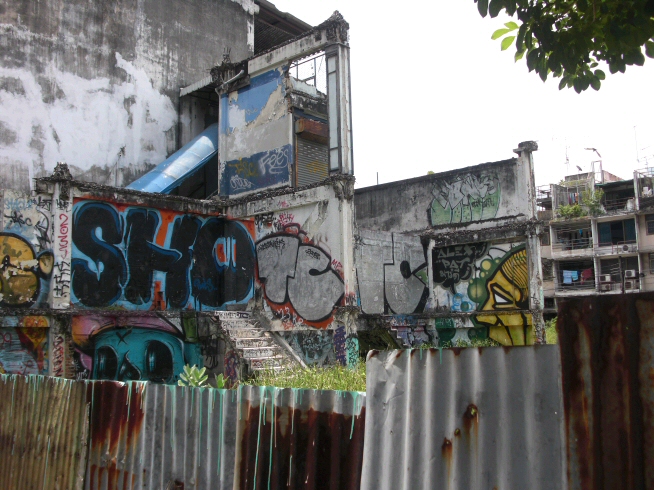
On the Other Side of the Railroad Tracks
But as dirty and hot as those inner city streets seemed, it was nothing compared to those who live by the railroad tracks. Bangkok has a subway system, which I didn’t see. It has a new Sky Train, which is quite fantastic — the air conditioning is superb and a welcome relief to the outside swelter. Coworkers recommended the Sky Train over a cab to get most places — take the Sky Train to X stop and then get out and take a cab from there is the best way to get just about anywhere. A brand new Sky train from the airport to the city is being built and expected to be completed by end of 2009. And then there is one more train — the classic, old passenger train whose tracks cut through Bangkok East to West through the Northern portion of the city. I came upon these tracks, and took to them, walking along the train tracks to see where they’d take me.
Along those tracks people live in utter poverty that hasn’t been seen in America since the Depression. Ramshackle shacks fill in either side of the railroad tracks; put together with plywood, and inundated with all kinds of garbage, with the cock-a-doodle-do’s of roosters filling the air. I spent two weeks on a farm in Cortland NY in the summer of 1983, and I know how fucking annoying roosters are. They don’t just crow like an alarm clock at 6am and then allow you to go back to sleep. They crow all fucking morning long. As I walked through this horrifically poor area, with roosters crowing, I couldn’t help think about Swine flu or some other kind of outbreak and those questions on the blue Customs card at the airport that always ask you if you’ve come close to poultry or livestock when abroad. I did my best Roy Scheider walking down these tracks, not knowing how dangerous this part of town was. Asian people seem to make up 99.9 percent of the population in Bangkok — seeing a caucasian person is a rarity — you say to yourself “look, there’s another caucasian person; I wonder what the heck he or she is doing here”, knowing they are probably thinking the same thing about you. So it’s not like you can be inconspicuous walking through town.
There are garbage cans here, although it looks like the garbage hasn’t been collected for some time.
There was another amazing thing about this area — despite the fact that these people were living in garbage, inches from the railroad tracks, they weren’t bums. These were the homes of entire families; some of these shacks had a motorcycle parked out front — possibly the family’s ride or perhaps a ticket to taxi-cab-driver income. Laundry was hung outside to dry. And some of the plywood of the houses had .. advertisements on them! Like for instance a bunch of Coke ads. An inadvertent consequence of picking up a piece of plywood with ads already on it? Or had the ads been posted on the plywood ramshackle house to advertise to passer-by’s on the train?! I also caught site of a boxing ring. I could imagine what that ring was like on a Friday or Saturday night.
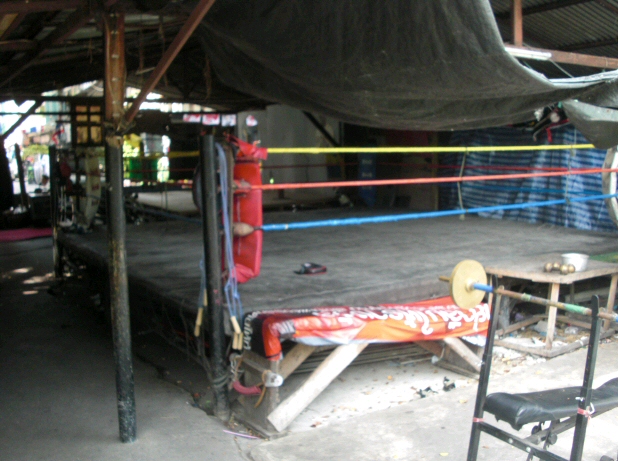
Living amongst the garbage.It seemed clear that this was not recession-caused poverty; it was more like immigrant-with-nowhere-else-to-live poverty, and some of it out-and-out land grab. And I suppose you wouldn’t want to build fine brick or wooden houses if you were doing a land grab — maybe ramshackle with lots of garbage gets public opinion off your back.
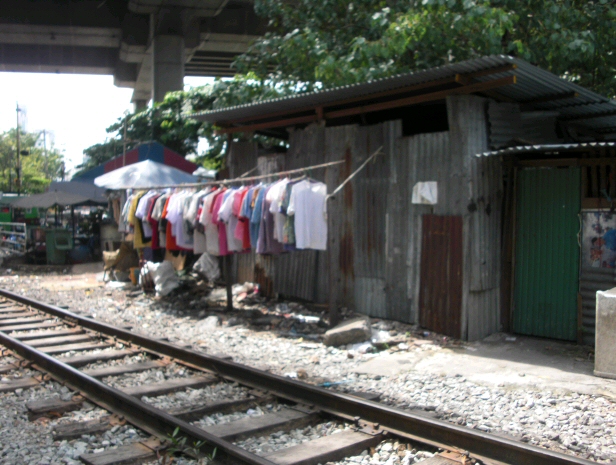
I found out later — back home on the internet — that the train that traverses those tracks is the State Railways of Thailand (SRT) train. You can take that train north over the River Kwai in Thailand — not to mention Hellfire Pass and Burma Death Railway. You can also take it south to the magnificent beaches of Thailand and to Kuala Lumpur of Malaysia. Man I wish I had had some time to jump on board that train.

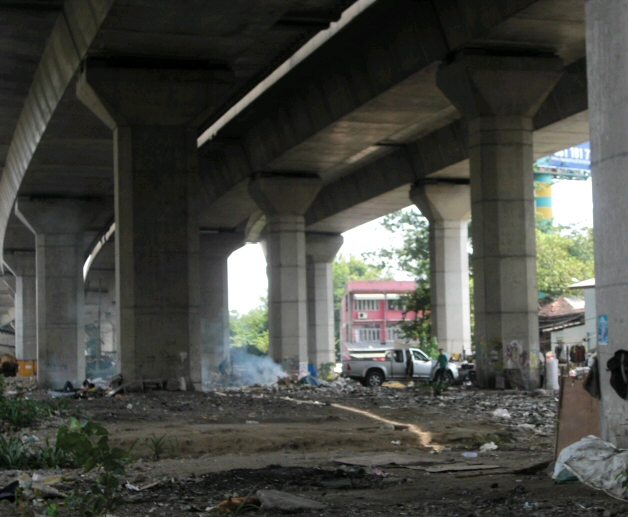
Telephone Lines Going Underground
On the cover of a magazine that lie in a Thai restaurant across the street from the hotel, there was a picture of Bangkok from the 1950’s that looked so familiar — it was a picture of one of the canals of Bangkok, filled with straw roofed fishing boats. That was the Southeast Asia I grew up knowing.
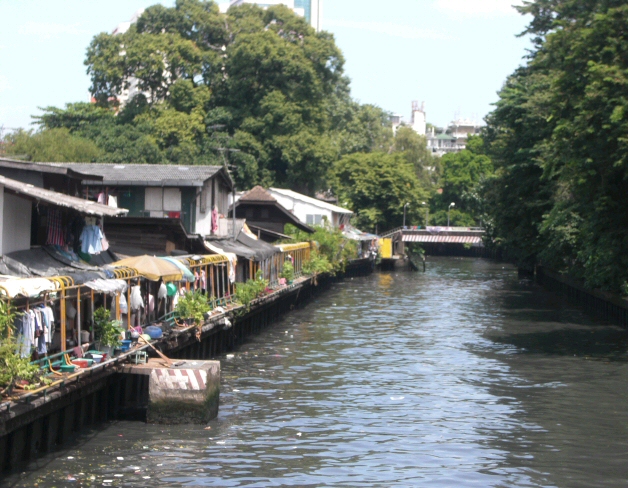
Bangkok has grown so fast it’s outpaced itself, especially in the area of its telephone and internet cable network. All of the cables are above ground, which results in this spectacular and awfully dangerous looking array of telephone land cable lines that are strung above you, often inches above eye level. It’s all part of the status quo to locals. For me, crossing a bridge and seeing those cable lines a half an inch above my head was a bit startling. I learned that Bangkok is working on a plan to put all of those cables underground; they just aren’t there yet. My Thai coworker remarked that the Thai government had spent more money on one F-16 fighter jet than it would have cost to put all the telephone cables underground, and no one was quite sure why Thailand needed the fighter jet.

Danger abounds in Bangkok. As money pours in and the city rebuilds and reinvents itself, it can’t possibly apply the money to all areas of the city. So you get fabulous new areas like the Siam Center — one of the largest and most elegant and super-fabulous shopping malls I’ve ever seen — and three blocks away, there are missing manhole covers in the sidewalk that would plummet the unattentive walker into a watery abyss. I saw a cement stairway to a bridge overpass completely missing its left supporting side, so that the stairs jutted out like peninsulars. They had just enough staying power to keep you up as you climbed the stairs. Good enough, by Bangkok’s city surveyor’s standards.
Girls on the Backs of Motorcycles
Motorcycles and Toyota Corolla’s abound in Bangkok. Every taxi cab is a Toyota Corolla — they are the equivalent to a NYC taxi Ford Crown Victoria. The recent vintage Toyota Corolla is bigger than Corolla’s of years past; they are almost as big as the Camry now. Bangkok’s taxi Corolla’s are different colors depending on the taxi company; most are pink but there are many blue, and some yellow taxis. If it is two-tone green and yellow, then it is a privately owned taxi, I learned from a co-worker. And if you’re not in a Toyota Corolla taxi, then most probably you are riding a motor cycle — either a taxi motorcycle (the driver wears a yellow vest), or a private motorcycle. If you are a woman, you are riding on the back of your man’s motorcycle, and many women sit with both legs off to one side, to be proper. I asked a coworker if there are many incidents of women falling off motorcycles, and he said yes — especially due to the fact that they sit side saddle; there are constant accidents and deaths. Bangkok has not figured out a way to control its traffic; and so the traffic is insane, and the carbon monoxide output will make you nauseous as you walk through many of the major intersections in town. The smog combined with the high heat and blazing sun and humidity make it so that you don’t see anybody exercising outside. There are no runners in Bangkok.

High Technology Malls
Again, Bangkok has over 6 million people, and an estimated 15 million if you count the uncounted. While rust-belt cities in the US like Buffalo; Cleveland; Toledo Ohio; and Flint, Michigan are trying to invent ways to attract people, as their population bleeds every year, Bangkok can’t stand out of the way of being a city on the rise, with jobs and people pouring in. The recent recession has been felt in Bangkok, and there is local debate (written up in the local newspapers) whether exports should continue to fuel the economy, as they have the past 10 years, or if there should be a shift toward domestic purchases fueling the economy.
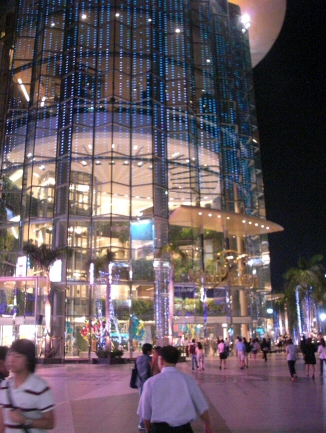
There is a large middle class living in modern buildings that I haven’t covered in this article. According to co-workers, the typical Thai prefers to live in a house; only young single people in their twenties will live in a condominum; so it’s the same as everywhere else.
That domestic purchasing power can be seen in places like the Siam Center — that incredible mall mentioned above. It is like the city of the future at Disney World, and the most elegant of shopping malls rolled into one. For the tourist looking for a bargain, there is MBK, a massive, multi-level mall-like flea market, where cheap prices for designer items (clothes, jewelry, sneakers, etc) that ‘fell off the back of the truck’ abound. You are expected to bargain down prices here; so if you see something you want to buy, hold it up and then walk away and wait for the salesperson to give a counter offer.
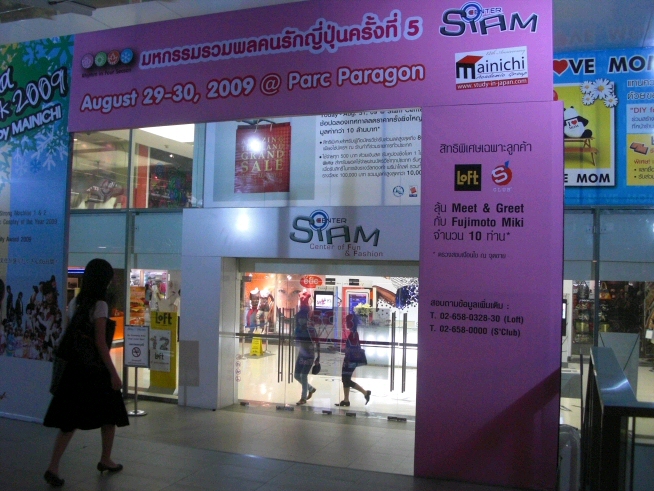
I hit this mall on the last few hours in Bangkok — after walking all morning, visiting a client in the afternoon, going back to the hotel to change for my flight back, taking a second shower, I collapsed into a Sizzler — the Western, American steakhouse — for a hamburger (350 Bots, equivalent of $10 US, as compared to a steak that was $20) — my first non-Thai meal in Bangkok. The hamburger included full access to the salad bar, so it was quite a cheap meal. Sizzler was jammed with young Thai people — everyone seemed to be in their twenties as I looked around.
The skytrains are all painted with ads, which are actually sun screens covering the windows and exterior of the cars. Shown here is a skytrain (above) pulling into Siam Center station.
Getting There
Getting to Bangkok from the Eastern US offers one of the more lengthy airline flights you can imagine. You are literally traveling to the other side of the world. If you fly to Southeast Asia from the West coast of the US, you do so over the Pacific Ocean, so it’s usually a one-stop flight, albeit a long one. If you travel to Southeast Asia from Europe, it’s a very long 11+ hour flight. However if you’re traveling from the East Coast of the US like I am from New York City, then it’s a 6+ hour flight from Newark (or JFK) to London, a 2-hour layover in Heathrow Airport — and you almost need every minute as you race from Terminal 5 to Terminal 4 via a 20-minute bus ride, go through customs and passport control and security again, and then take a train within terminal 5 to get to different gate areas. And then that 11+ hour flight to Bangkok. Plus there’s an 11-hour time difference that spins you. To put it in relative terms, I left Newark Airport at 8am on a Saturday morning and arrived in Bangkok at 3:30pm on a Sunday. Not so bad; the hours melt away pretty quickly, even on the 11+ hour flight, especially if your computer laptop battery has a full 3 hours of life on it, and you watch 3 movies and get a bunch of hours sleep.


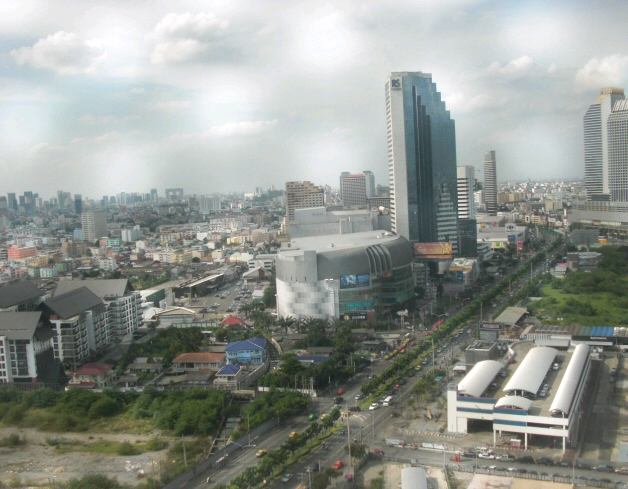
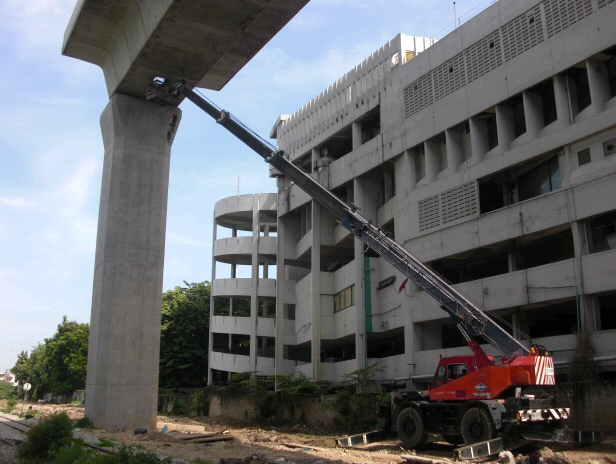
More Pictures
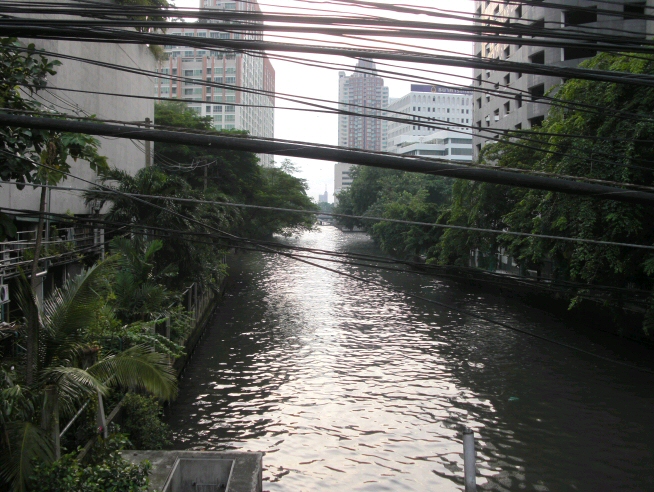
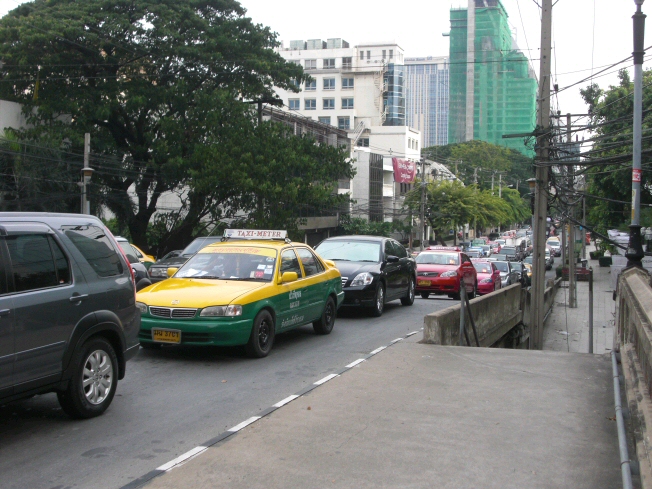
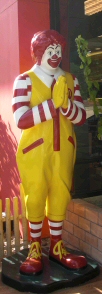
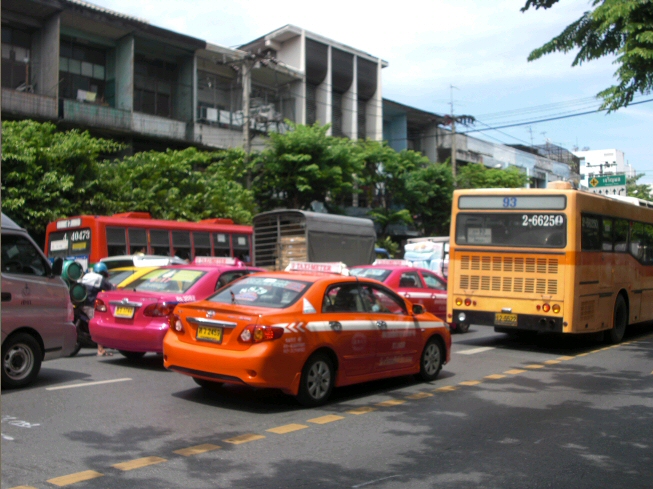
Huge portraits of this lady were everywhere — she must be the leader of Thailand or something.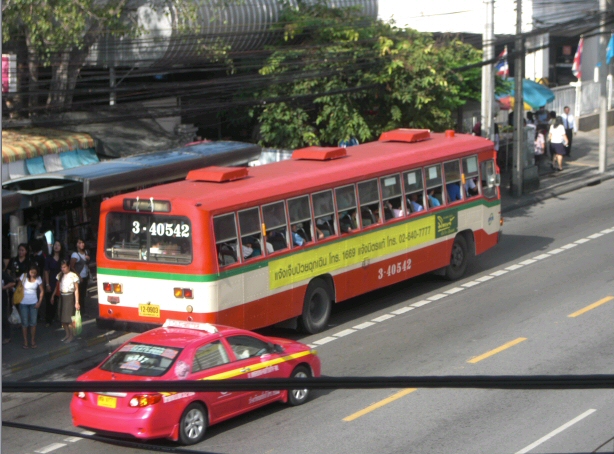
Tell Us What You Think: Comment via your Facebook acct below or via email by clicking here.
Reader Feedback
| Quite helpful because I have been searching about travel through Thailand; thanks for update on this site.
Soluy Hansen |

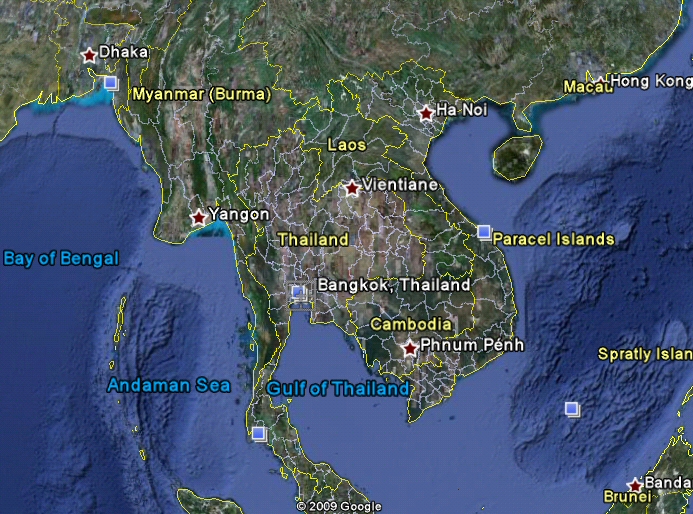
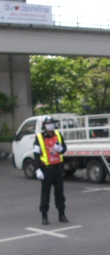
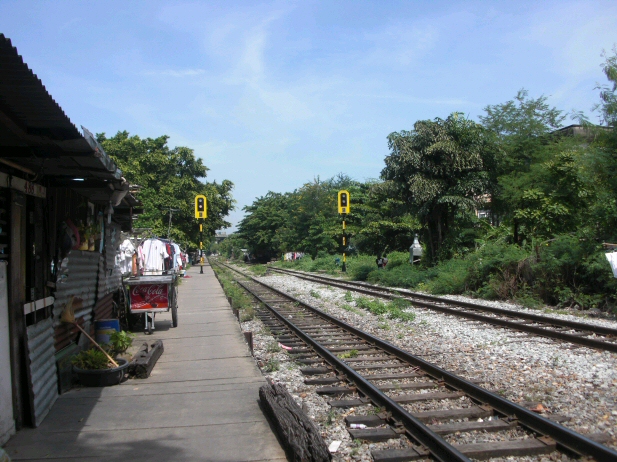

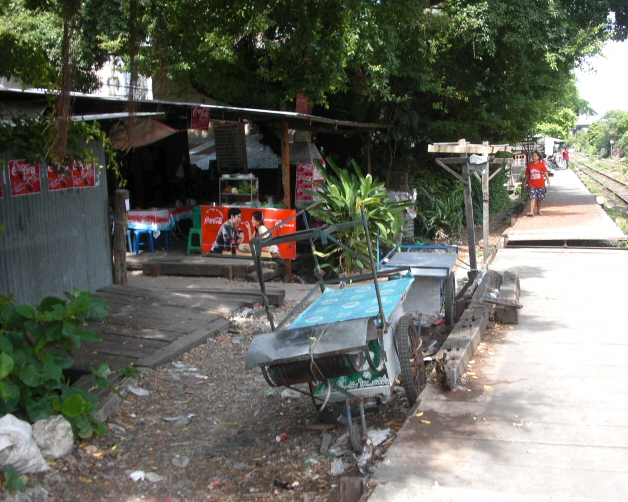
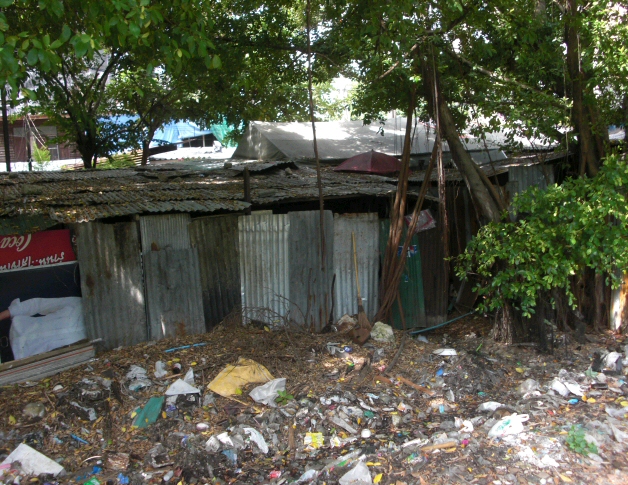
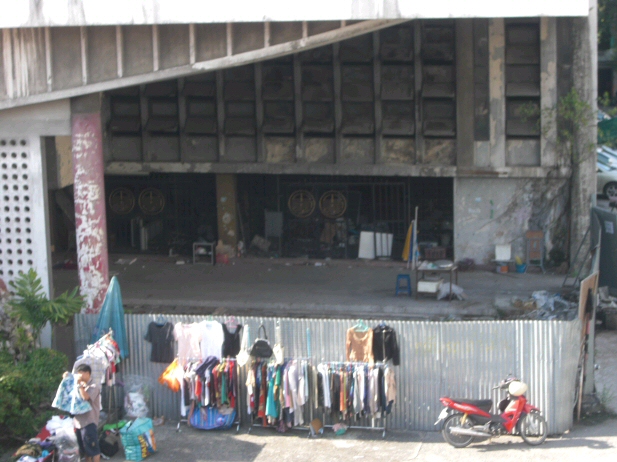
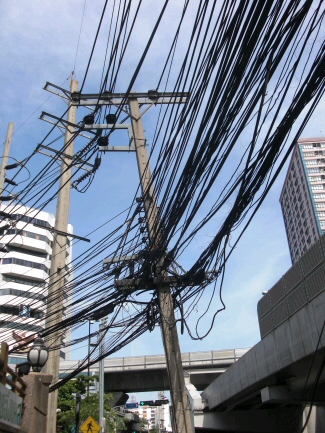


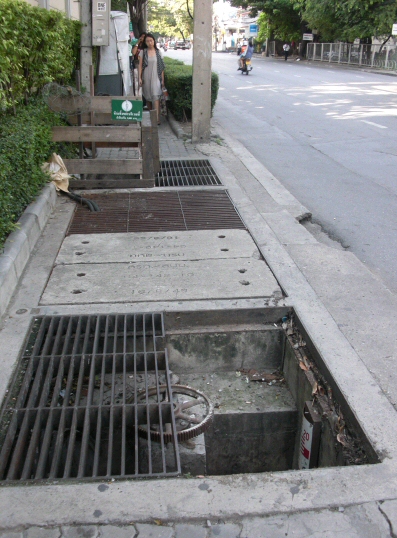


Be the first to comment